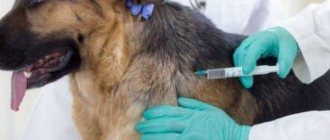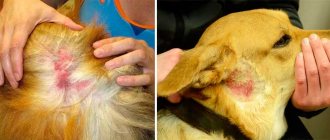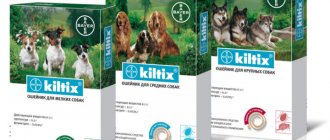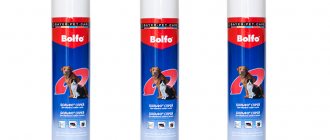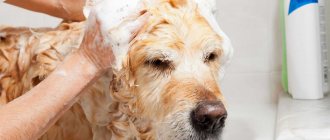Allergy is the body's hypersensitivity to antigens. The disease manifests itself when an allergen penetrates into the blood through the mucous membranes, skin or respiratory system.
Allergies can develop in humans and any animal, including dogs. Pets often suffer from dermatitis caused by a flea bite. The saliva of parasites contains substances that provoke hypersensitivity reactions.
These include rash, swelling, sneezing, watery eyes, or itchy skin.
Failure to treat these symptoms often leads to the development of more dangerous skin diseases. Sometimes the animal dies due to anaphylaxis, cardiac or respiratory failure.
Therefore, when an allergy appears, it is important to immediately get rid of fleas and carry out comprehensive anti-allergy therapy.
Symptoms and behavior of animals
Manifestations of flea allergy can be noticed by the rapidly changing behavior and condition of the pet. Symptoms of flea dermatitis in dogs:
- Severe itching. The dog itches continuously, which leads to redness of the skin and the appearance of abrasions and open wounds on it.
- Dandruff. Small white flakes can be seen on the fur.
- Unpleasant odor emanating from the body and mouth.
- Lack of appetite.
- Digestive system disorders: frequent constipation or prolonged diarrhea, nausea and vomiting.
- Formation of edema on the mucous membranes.
- Dryness and flaking of the skin.
The pet's behavior changes radically: it becomes lethargic, refuses to go out, ears droop, and constantly wags its head.
Symptoms of the disease
In total there are about two thousand species and subspecies of fleas. Most of them are parasitic throughout the body, however, a few varieties live exclusively on the face, on and around the ears. Usually, it is almost impossible to notice these tiny creatures with the naked eye, unless the condition of the infected animal has become critical.
As noted earlier, many skin diseases are caused by flea attacks. According to French researchers in 1992, the breeds most susceptible to the saliva of these bloodsuckers are:
- setter;
- fox terrier;
- chow-chow;
- Pekingese;
- spaniel.
There are other equally allergic dogs, such as pit bulls and sharpeis.
The clinical manifestations of parasite infection will depend not only on the sensitivity of the animal, but also on the number of insects on its body. The main signs of infection are:
- restlessness, irritability, barking, whining;
- dry skin, the appearance of peeling and crusts;
- itching, accompanied by endless scratching and licking of the affected areas;
- alopecia, bald patches, excessive hair loss;
- scratches, papules, weeping eczema;
- formation of fibrous nodes in the back, lower back, inner thighs and abdomen;
- hyperpigmentation and thickening of the skin;
- the pet noticeably loses weight and looks bad;
- in some cases, a worried dog refuses to eat and appears lethargic and lethargic.
It is important that even single bites provoke a strong allergic reaction, for example, while walking on the street. Only in 30% of cases do animals experience a slow increase in symptoms.
Self-diagnosis
The owner can determine the presence of an allergic reaction to parasites in a dog independently through a thorough examination. Fleas choose to settle on the rump, stomach, root of the tail and inner thighs. When an allergy develops, the animal begins to intensively scratch these areas. Having parted the fur, the owner will find a large number of fleas and nits. The latter are not difficult to identify: they look like a small black dot and can be easily removed from the animal’s fur with your fingers. Female fleas, engorged with blood, are brown in color and have a large body.
The combination of a large number of parasites, constant itching in the animal and the presence of inflammatory foci with purulent contents on the body indicate that the dog is allergic to flea bites.
There are situations when a dog has only a few parasites on its body; the rest hide in carpets and upholstered furniture, periodically attacking the animal. Even if the owner has no doubt that the pet is allergic to flea bites, before starting treatment, it is necessary to show the animal to a veterinarian to clarify the diagnosis.
Diagnosis of secondary skin infections in dogs
There is often a secondary infection that develops on the dog's skin with FAD. Your veterinarian may use cytology to diagnose any secondary skin infections.
Cutaneous cytology is a valuable diagnostic tool. Using a piece of tape to take a superficial sample from a skin lesion helps determine the type of microbial population as well as the inflammatory component present.
It's fast and inexpensive. This helps the doctor prescribe the most appropriate and effective treatment to the patient.
How dangerous are flea bites for humans?
Parasites are able to coexist with a person in his home for years. In addition to painful bites and unpleasant red spots, fleas can transmit dangerous infectious diseases. Their treatment can take a lot of time and a large amount of money. Here is a list of the most dangerous viruses ever carried by fleas:
- Typhus : the infected person has a high fever, vomiting, and aches.
- Brucellosis : the disease seriously affects the human nervous system, the temperature rises. Often the disease develops into more acute forms. This leads to arthritis and disruption of the reproductive system.
- Anthrax : the patient's body becomes covered with non-healing ulcers. The infection affects internal organs and is fatal.
They say that fleas can carry the pathogens of dermatitis , hepatitis and encephalitis . An attack by parasites can trigger allergies .
Frequent flea bites have a detrimental effect on the nervous system . Because of this, constant phantom pain occurs. At this moment the person feels a sharp prick, but the bite mark does not appear. Some people even start to itch their entire body at the mere thought of insects. In this case, only complete disposal of parasites using specialized means and sedatives will help.
Flea collars for dogs
Flea collars are very popular among most dog owners. Flea collars are a fairly effective flea preventative. Flea collars sold in pharmacies come in three types:
Chemical (contain special anti-flea chemicals), biological (contain essential oils and plant extracts) and ultrasonic.
For pregnant dogs and those suffering from intolerance to chemical flea medications, biological and ultrasonic collars are the only means of flea control.
Danger and possible consequences
Allergies in dogs require immediate treatment, since the disease can cause a number of complications and serious consequences. Intensive scratching of the skin leads to the appearance of open wounds, in which a favorable environment is created for the development of pathogenic microflora that comes from the outside or is brought in by the parasites themselves. This leads to the appearance of purulent-inflammatory processes that provoke severe intoxication of the animal.
Late treatment of allergies can lead to dermatitis becoming chronic with frequent outbreaks of relapses. A weakened animal’s body and a depressed immune system can lead to consequences such as heart or respiratory failure. Untreated parasite allergies often lead to the death of dogs.
Formation of wounds due to flea bites.
How to remove fleas from puppies
You should not allow fleas to appear on your puppy. His immune system is still extremely weak, so the consequences of parasite bites can be severe. This can affect both the health of the pet and its further development. Before using any product, you should consult a veterinarian, because many drugs are approved from 6-7 months.
If you purchase shampoo, it must be intended for puppies, as indicated on the packaging. Other drugs should be made only on a natural basis.
Allowed for puppies from 1.5-2 months:
- shampoos – Doctor Zoo, Beafar, Phytoelite, Celandine;
- collars – Hartz, Beafar;
- drops – Celandine, Frontline spot;
- spray – Bars, Stronghold.
Main symptoms
Flea allergy is a pathology that occurs quite often. This is a reaction to allergens present in the saliva of insects. The main features of this type are:
The environment also often causes allergies in living beings. These are flowers, fibers of natural materials, mold, dust mites. If the allergen is always in the house, then the pet’s reaction will be constant. In other cases, the disease manifests itself seasonally.
There are two types of environmental allergies:
- Atopy is a hereditary tendency to allergies to the external environment. This is the most common type. Mostly seasonal atopic dermatitis is observed. Seborrhea and dry skin appear.
- Contact allergy. Formed due to the interaction of a dog with an object where the allergen is located. Usually seen on the paws, face, and stomach lining.
What is flea allergy dermatitis in dogs?
Fleas eat their first blood on the host (your dog) within minutes of contact. When a flea feeds, it injects its saliva into your dog's skin.
This saliva contains enzymes, peptides and amino acids. It also contains histamine-like compounds, which cause the dog's immune system to release.
Flea saliva can cause an inflammatory reaction in animals that are sensitive to it. Some dogs experience hypersensitivity to it within 15 minutes, while others have a delayed reaction that takes 24-48 hours.
Dogs with atopic dermatitis are more likely to develop flea allergy dermatitis.
Features of the course of allergies
The reaction to flea saliva in dogs is related to the season of the year. Most often, an allergy outbreak occurs in spring and summer. Signs may appear immediately after the bite or be sluggish, it all depends on the degree of sensitivity of the body. But in most cases, reactions occur due to numerous bites and prolonged presence of parasites on the animal’s body.
The first sign is itching, which can last from several hours to 2 days. Other symptoms:
- deterioration of skin condition;
- changes in general condition and behavior: appear after several weeks or months, depending on how sensitive the animal’s skin is.
In order to detect the disease in time and prevent the condition from worsening, you need to immediately respond to the appearance of prolonged itching in your pet. Timely examination and provision of veterinary care will help save the dog not only health, but also life.
What causes
The saliva that a flea secretes when biting a dog contains one and a half dozen different substances designed to reduce blood clotting. Any of them can cause allergies. One bite is enough to make the animal sick. For individuals with weakened immune systems, the risk of getting sick increases.
It doesn't matter that the dog may not have fleas at all when examined. There are many types of these insects. Some do not live on animals permanently, but jump onto the skin only to drink blood.
A purebred dog is nowhere completely immune from contact with fleas, especially in the summer, when all types of fleas become more active and contacts with other animals expand.
Which breeds are more susceptible
Flea dermatitis can occur in any dog, without exception, regardless of gender, age, or breed. The severity of the disease depends on the individual characteristics of the body, the rate of progression and the severity of the allergic reaction.
Dermatitis caused by flea bites is most often diagnosed in representatives of short-haired breeds - dachshunds, Labradors, bulldogs, boxers, Rottweilers, German shepherds.
Causes in animals
The factor that provokes the development of this disease is flea saliva. It contains several substances that can reduce blood clotting. They are the ones who provoke the development of an allergic reaction.
Factors contributing to the development of autoimmune disease are:
- reduced immunity;
- poor nutrition;
- insufficient physical activity of the pet.
The breed, age, and living conditions of the animal play a secondary role in this case. Dog owners need to remember that one insect bite is often enough to infect an animal. During the inspection, he may not find flea larvae or adults on it. But the pet will be diagnosed with flea dermatitis if the pathology was caused by the saliva of this insect.
Actions for anaphylactic shock
A large accumulation of parasites on the body and numerous bites can provoke anaphylactic shock, leading to the death of the animal without proper assistance. In this condition, the dog must be urgently taken to a veterinary clinic. If you can’t do this quickly, you can save your pet’s life by providing the correct first aid:
- If the dog is conscious and able to swallow, it should be given an antihistamine. The medicine will help reduce the intensity of symptoms.
- Breathing is accompanied by gurgling sounds - a sign that the lungs are filling with fluid. If the animal is conscious, it must be taken by the hind legs and lifted, holding in this position for 10 seconds.
- The dog is not breathing - artificial respiration is required. The pet should close its mouth and inhale air quickly and rhythmically 2 times into its nose. In 1 minute you need to take 15 to 20 breaths into the nose until the animal begins to breathe on its own.
Anaphylactic shock in a dog. After all the manipulations have been completed, take the pet to the hospital. At the veterinary clinic, the animal is administered anti-shock and potent antihistamines, and symptomatic therapy is provided if necessary.
Flea shampoos for dogs
Flea shampoos have a short-term residual effect. Therefore, their use is justified for the immediate removal of fleas from dog fur.
When washing your dog, you need to protect its eyes and nose from getting shampoo in them. The veterinary pharmacy chain sells the following flea shampoos:
- "Doctor Zoo" The shampoo contains essential oils from several plants as repellents.
- "Beapar." The active ingredient is permethrin.
- "Phytoelite". The active ingredient in shampoos is permethrin. Additionally, infusions of several herbs are added to the shampoo.
- "Master Bruno" The main component of shampoos is permethrin. This shampoo is used for dogs from 4 weeks of age.
- "Celandine". The active substance is permethrin.
Prevention
It is quite simple to protect your pet from infection by insects of any kind, if you do not forget to carry out regular preventive treatment of the dog and the room in which it is kept.
Specific actions for prevention:
- Processing with special means . Use flea shampoo regularly when bathing. Once a month, apply drops or spray, or wear a special collar.
- Limiting contact with homeless people and obviously infected animals. Choose places for walking away from possible breeding grounds, which are trash cans and places where dogs constantly gather.
- Weekly wet cleaning of the house and monthly special treatment against parasites . Fleas often only feed on the host; they prefer to live and reproduce in more secluded places. Therefore, treatment with insect repellent compounds is carried out regularly. At home, a solution of vinegar or citrus fruits in water is perfect for this.
- When accepting a gift of another animal's belongings, find out whether the animal has ever been sick. In any case, subject them to heat or special treatment, since flea eggs may not be visible to the naked eye.
Regular high-quality prevention will protect your pet and family from parasites and significantly reduce the risk of contracting many diseases carried by fleas.
Home care
The owner will significantly speed up the pet’s recovery if he organizes proper care and fulfills all the doctor’s requirements for sanitizing the dog’s place of residence and itself:
- Insecticidal treatment. Cleaning and cleaning with insecticidal agents of dog equipment and premises is carried out until all parasites are completely destroyed. The range of insecticides is large and available, but it is better to rely on the advice of the treating veterinarian. Flea products from the brands “Hartz”, “Frontline”, “Bolfo” and the budget but no less effective “Bars” have proven themselves well. If funds are not available, then prepare a decoction of wormwood, tansy or an aqueous infusion of garlic, which is used to treat the room, things and the animal itself.
- Proper nutrition. The diet should be complete, but consisting of foods familiar to the dog. Vitamin supplements should only be administered with the permission of a physician. During the treatment period, you should not try new types of food, treats, or allow errors in nutrition, so as not to provoke other allergic reactions that will blur the clinical picture. The same applies to the use of traditional medicine and veterinary medicine: use them only with the approval and under the supervision of a doctor, since any plant substance may be an allergen.
- Strengthening the immune system. You can't do without fresh air and movement! Physical activity affects metabolism, so full walks are necessary. In total, the duration of walking, depending on the breed, lasts from one and a half to two and a half hours a day. In this case, the dog should be treated with repellent or equipped with a flea-repellent collar to avoid coming into contact with fleas again.
Important: without taking the above measures, healing the dog will take a long time or become impossible! In areas where qualified veterinary care is difficult to access, emergency and preventive treatment with insecticides is the only effective way to cope with the disease!
Allergy treatment
Treatment methods are selected depending on the severity of the symptomatic picture. But the first thing the owner needs to do is rid the animal of parasites using special shampoos and drops. In addition to cleaning the dog's skin and fur from fleas, it is recommended to disinfect all furniture in the house, carpets and bedding that may contain them.
A diet is required. When feeding a dog with ready-made commercial diets, it must be switched to hypoallergenic food. If the pet is on a natural diet, the veterinarian selects the menu for her.
Drug therapy
When treating flea dermatitis, antihistamines are necessarily prescribed to inhibit the effect of the hormone histamine and relieve the signs of pathology. The following drugs are used in therapy:
- Diphenhydramine. The drug eliminates inflammation and relieves allergic reactions.
- Cyprodine. This is an oral medicine. Cyprodine eliminates fever and relieves severe itching.
- Diprazine. Release form: tablets and solution for intramuscular administration.
- Astemizole. The medicine should not be given to pregnant dogs.
If the allergy is advanced and antihistamines do not give a positive result, the animal is prescribed glucocorticosteroids. To restore the body depleted by allergies, vitamin complexes, immunomodulators and supporting drugs that contain iron are used.
Folk methods of struggle
Along with taking medications, traditional methods of therapy can be used in the treatment of flea dermatitis. To speed up the healing process of the skin and relieve itching, it is recommended to treat the affected areas of the skin with decoctions based on medicinal herbs: chamomile, calendula, coltsfoot, comfrey and sage.
All decoctions are prepared according to the same recipe:
- 1 tbsp. l. the selected herb is poured with a glass of boiling water.
- The liquid is infused until it cools completely, after which it is filtered.
- A cotton pad is moistened with the decoction. They treat the skin carefully, without pressing too hard.
Aloe heals skin well. It is recommended to grind the cut leaf of the plant into a paste and apply it to the skin for 30 minutes. Since aloe has a pronounced laxative effect, it can be used in areas where the dog cannot reach with its tongue.
Aloe juice purchased at a pharmacy can be added a few drops to your pet’s food. This will help improve digestion and strengthen the immune system so that the body can independently resist allergens, thereby reducing the intensity of symptoms of the disease.
Echinacea is another effective remedy for treating flea dermatitis in dogs. Gauze, folded several times, should be moistened in it and applied to the damaged area. Keep the compress for up to 30 minutes.
It is important to remember that traditional methods cannot be used as the only method of treating flea allergies in dogs. Such treatment is only an addition to the main drug therapy.
What to do at home
Treatment of flea dermatitis occurs through the use of medications. Traditional medicine can be used, but they cannot completely replace therapy prescribed by a veterinarian. Self-medication is very dangerous for a dog’s health.
The treatment process is long and will require a lot of patience from the owner.
Among traditional medicine methods, the most popular and effective is a solution of soapy water with essential oils (cedarwood, tea tree, lavender). The components are mixed in equal parts with soap foam, and the solution is applied to the wool. Treatment time: before and after bathing.
Great importance should be given to the dog's nutrition during the treatment of flea dermatitis. Your four-legged pet should be fed with special premium food marked “Hypoallergenic”. It is also allowed that during illness the pet will receive only natural food, including foods that it has never tried before, for example, duck, venison, fish.
It is advisable to include potatoes and pumpkin porridge in the menu. Fermented milk products, beef, and wheat are excluded from the diet, which in 80% of cases provoke allergies in dogs.
During the period of treatment of flea dermatitis, it is necessary to strengthen the animal’s immune system, so it is necessary to consult with a veterinarian about choosing a suitable vitamin complex.

